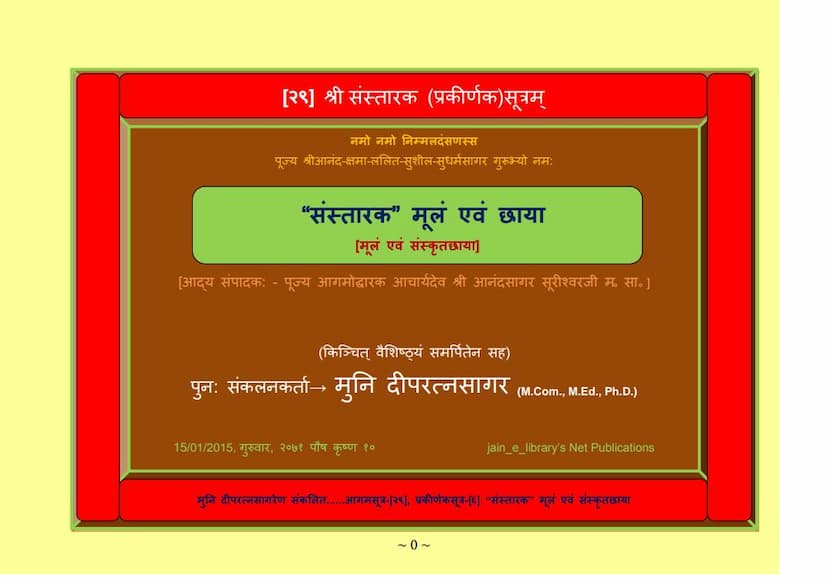Aagam 29 SANSTAARAK Moolm Evam Chhaayaa
Added to library: September 1, 2025

Summary
Here is a comprehensive summary in English of the Jain text "Aagam 29 SANSTAARAK Moolm evam Chhaayaa":
Book Title: Aagam 29 SANSTAARAK Moolm evam Chhaayaa (Shri Samstarak Prakeernaka Sutra) Author(s): Dipratnasagar, Deepratnasagar Publisher: Deepratnasagar Catalog Link: https://jainqq.org/explore/004129/1
Overall Context:
This Jain text, "Samstarak" (संस्तारक), is identified as the 29th Agam Sutra and the 6th Prakeernaka Sutra. The specific edition summarized here is a compilation and re-editing by Muni Deepratnasagar, published by Deepratnasagar. It presents the original Prakrit text (Mool) of the "Samstarak Sutra" alongside its Sanskrit translation (Chhaayaa). The work acknowledges an earlier edition (1927, Vikram Samvat 1983) by the Agamodaya Samiti, edited by Pujya Agamoddharak Acharya Dev Shri Anand Sagar Surishwarji (Saganand Suriji), and details the efforts made by Muni Deepratnasagar to enhance its accessibility and scholarship.
Key Themes and Content:
The "Samstarak Sutra" primarily focuses on the profound significance and practice of Samstarak (संस्तारक), which can be understood as a state of equanimity, detachment, and peaceful acceptance, particularly in the face of adversity and the final moments of life. It is a core concept in Jainism, emphasizing the spiritual discipline required to attain liberation.
The text can be broadly categorized by its content:
-
Introduction and Significance:
- It begins with salutations to the Jinas and the spiritual lineage of gurus.
- The text establishes the importance of Samstarak as a state of enlightenment and a means to achieve ultimate liberation. It is described as the "flag-bearer" for the well-behaved (Suvihita) and a symbol of their achievement.
-
Metaphors and Analogies:
- Numerous metaphors are used to illustrate the supreme value of Samstarak:
- It is compared to the lion among men (Purushvarapundareek) and the mother of Jinas (Jinajaniyo) for women.
- It is likened to the Vajra jewel among gems, Kouśīla among perfumes, and sandalwood among fragrances.
- It is considered the Jina dynasty among lineages, the householder community among all families, the path to liberation among all states of existence, and liberation itself among all forms of happiness.
- It is the highest Dharma among all duties, authentic speech among all sayings, and the word of the Jina among all scriptures.
- It is the auspiciousness among all auspicious events, like the abhishek of gods.
- Numerous metaphors are used to illustrate the supreme value of Samstarak:
-
Qualities of the Practitioner (Suvihita):
- The sutra elaborates on the qualities of an individual who attains Samstarak:
- They are free from pride, ego, and attachment.
- They possess pure knowledge, faith, and conduct (Samyaktva, Jnana, Darshana, Charitra).
- They are steadfast in their vows and practices (Samvara, Nirjara).
- They are free from anger, pride, deceit, and greed (Kashayas).
- They maintain control over their senses and mind.
- The sutra elaborates on the qualities of an individual who attains Samstarak:
-
The Practice of Samstarak:
- The text details the process and circumstances under which one should undertake Samstarak:
- It is achieved through intense meditation (Dhyana) and self-control (Samyama).
- It involves overcoming hardships (Parishaha) and remaining detached from the body and worldly possessions.
- It is a conscious act of embracing the inevitable, leading to the annihilation of karmas.
- The text details the process and circumstances under which one should undertake Samstarak:
-
Examples and Narratives (Drishtantas):
- A significant portion of the text is dedicated to illustrative stories (Drishtantas) of individuals who practiced Samstarak and achieved liberation. These narratives often involve:
- Enduring extreme suffering: Many stories depict individuals facing severe physical torment, such as being eaten by animals, burned by fire, or attacked by enemies, yet maintaining their equanimity and devotion.
- Unwavering faith: Despite immense pain and the disintegration of their bodies, these individuals remained firm in their commitment to the Jain path.
- Attainment of Moksha: The narratives conclude with the liberation (Moksha) of these exemplary souls, highlighting the efficacy of practicing Samstarak even in the most challenging circumstances.
- Notable figures mentioned in these narratives include Sukumar, Chanakya, and various other ascetics and devoted individuals from different times and places.
- A significant portion of the text is dedicated to illustrative stories (Drishtantas) of individuals who practiced Samstarak and achieved liberation. These narratives often involve:
-
The Role of Forgiveness and Detachment:
- The text emphasizes the importance of forgiveness (Kshama) as a crucial element of Samstarak practice. It describes the act of seeking forgiveness from all beings and offering forgiveness in return, thereby purifying oneself.
- It also stresses the concept of detachment from the body (Sharira) and worldly attachments (Mamata), viewing the body as merely a vessel and the soul as the true essence.
-
Editorial Notes and Scholarly Contribution:
- Muni Deepratnasagar's contribution is highlighted, explaining his motivation to re-edit and publish this sacred text. He aimed to make it more accessible to a global audience through digital publication (jain_e_library.org) and to preserve the scholarly work of previous editors.
- The edition includes the original text, Sanskrit translation, and detailed indexing (Deep Anukram) to facilitate study and cross-referencing with other Jain Agams. Footnotes are also provided to clarify printing errors or numbering discrepancies from the original source.
In Essence:
The "Samstarak" sutra is a profound spiritual guide that elucidates the path to ultimate liberation through the practice of unwavering equanimity, detachment, and acceptance, particularly in the face of death and extreme suffering. It uses rich metaphors and inspiring narratives to illustrate the supreme spiritual merit of this practice and the qualities of those who embody it. The presented edition by Muni Deepratnasagar serves as a valuable resource for scholars and practitioners seeking to understand this significant Jain scripture.